Is it illegal to drive on a flat tire? You can’t drive with flat tires. To get your tire fixed, you might want to “limp” your tire to the repair shop. You can’t go with a flat tire! Having a flat tire can make your whole day a mess. You also might need the help of a tow truck since you might not be able to change your tire.
Driving on one or two flat tires can cause your car to break down and cost a lot of money. When you drive at high speeds while having a flat tire, you can do a lot of damage to both the tire and its rim. This will make the situation even worse.
When a tire gets punctured, you can patch the hole most of the time. But if you decide to risk it and keep driving, the situation could get worse, and you’ll have to change the tire and rim all at once.
To get to a safe location, you may have to drive over a flat tire at some point. A flat tire can cause serious damage to the tire and is unlikely to be salvageable if driven over.
So if you suspect that one of your tires has a slow leak, don’t risk driving down the road with a flat.
Is it Illegal to Drive on a Flat Tire?

Of course, anything that isn’t safe can’t be on the road. Also, you could get a ticket or be arrested for dangerous or unsafe conditions or something like that, too. If you live in your state, you might want to check its basic rules on hazardous driving.
Flat tires are dangerous to drive on. A flat tire can be dangerous, but it’s also difficult to stop right away and have the tire changed. To get there safely, you might have to drive your car there. If that’s the best thing for your rim, then drive there.
Most drivers will experience a flat tire at some point in their driving career. It could be the result of a nail, broken glass, or other construction debris puncturing your tire, or it could be the result of normal wear and tear, a leaky valve stem, or something else entirely. Flats happen at the most inconvenient times and in the most inconvenient places.
Driving on a flat tire can damage your rim if you’re in heavy traffic and can’t just pull over in the middle of the road. If you need to replace the rim, you’ll have to fork over hundreds of dollars in addition to the cost of a new tire. You can usually drive a few yards to get to a safe place, but driving more than about 100 yards almost certainly results in rim damage.
Additionally, if the vehicle is equipped with an all-wheel-drive, it could be damaged, resulting in even more expensive repairs.
What to Do When You Do Have a Flat tire?

If you can’t change the tire yourself, get a tow truck to take your car to a nearby shop. So, check the pressure in your tire. Also, take other safety precautions before and during your trip.
An auto shop could be held liable if they installed the wrong type of tire on their customer’s vehicle. Alternately, there’s always the chance that the tire itself is flawed. It’s possible that the manufacturer is to blame for a defective product. It’s possible that a retailer could be held liable if they knew they were selling a defective tire.
Damages can quickly spiral out of control when someone is injured in an accident. The injured plaintiff will seek compensation for both economic and non-economic losses. Among the possibilities are:
- Treatment in a medical facility
- Expenses incurred at the hospital
- Drug and medical supply prices
- If additional treatment is needed, such as physical therapy,
- Lost income and lost earning potential
- Distress and anguish
Can You Drive On a Flat Tire?
It will be hard to drive on a flat tire, and you might damage the structure of your vehicle. Drive on a flat tire, and you could pay for more than just a flat tire fix!
What to Do If You Have a Flat Tire

Take your car to a safe place that isn’t far away. The roadside is fine.
In this case, you could change the tire on your own. Use an emergency sealant if the tire doesn’t have a big hole, isn’t damaged, or isn’t all gone. Most of the time, the sealant is only suitable for 14 inches or fewer holes.
Preventing a Flat Tire
It can be hard to avoid nails, screws, or other sharp things on the road while going 55 miles per hour.
Pay Attention to Tire Load Limit
On the sidewall of each tire, there is a recommended pressure and a max pressure, and max weight.
The Legal Consequences That May Be Involved with Flat Tires

Most people will have a flat tire at some point or another. In some cases, this could start when you drive over something sharp like broken glass or nails. It could also be because of normal wear and tear, the valve stem leaking, or something else. Flats happen at the worst possible times and in the worst places, no matter the reason.
It’s dangerous to drive on a flat tire because it can damage your wheel’s rims. Because then not only will you pay for a new tire, but you may also have to buy a new rim. Usually, you can drive a few yards to get to a safe place, but it’s almost always wrong to go more than 100 yards. And if the car has an all-wheel drive, it could also be damaged, which means even more costly repairs.
Because of the flat, you might have to pay for more than just the repair costs. Every state has rules about driving too fast. There’s a lot of pulling to one side when a tire is flat. Flat tires make it hard to control your speed or advice when you’re on a bike. It can be hazardous, costly, and even have legal consequences.







